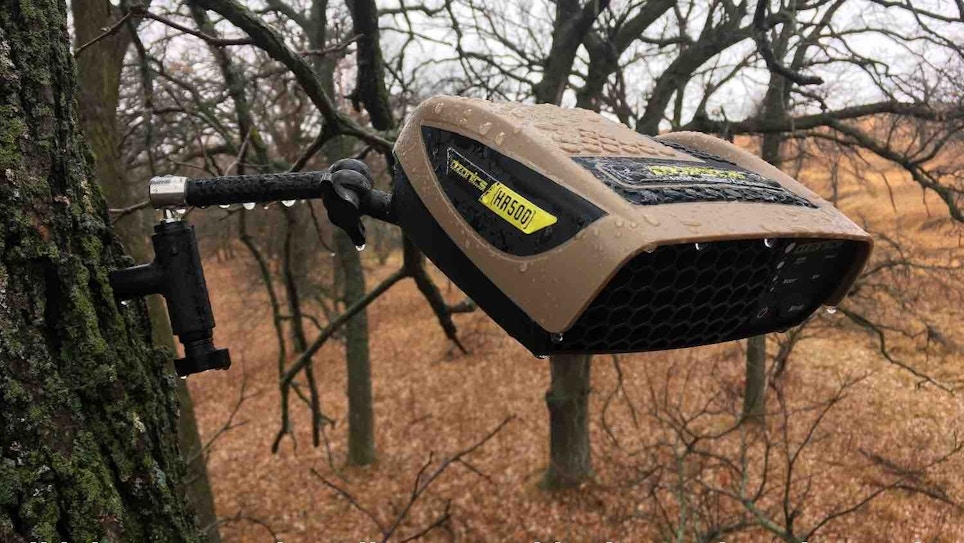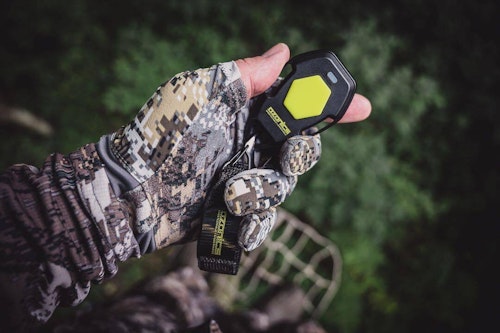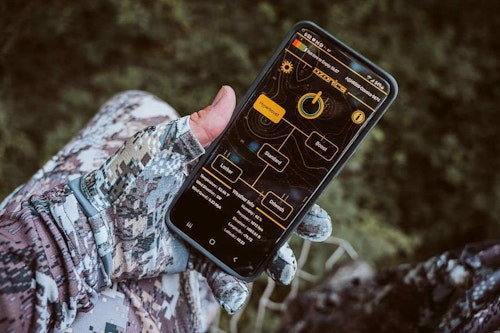
The author tested an Ozonics HR500 in a wide variety of challenging weather conditions, including sleet, snow and single-digit temperatures.
Anyone who knows me well — and my hunting buddies certainly fall into this camp — will tell you I’m not a “gadgets guy.” Yes, I keep an eye on latest hunting product offerings, but truth be told, the primary reason is because of my career as an outdoor editor; it’s literally my job to stay informed about new gear.
I’m quite satisfied with my current equipment list, and I rarely make an addition or change. During almost all morning or evening sits in a treestand or ground blind when pursuing whitetails, I carry everything I need in a standard-sized fanny pack and my pockets. In fact, I often make fun of my friends for packing the kitchen sink into their roomy day packs. (I could understand if we were on a wilderness backpacking trip for elk, but we’re chasing whitetails on the Back 160!)
One item that some deer hunters will no doubt classify as a gadget or gimmick is an Ozonics device. I first tried one in 2016 when a coworker was experiencing good success with it. He believed it was helping him avoid detection by whitetails, and he was curious to see whether I’d have the same result. He arrowed a decent-sized buck early that fall and was done hunting.
“Dave, just give it a try on your South Dakota whitetail vacation,” he said. “All you have to do is hang it over your head in the stand, point it downwind and press the power button. I think it makes a difference, but want to get your take on it.” (FYI: The specific unit was an Ozonics HR200, which has since been replaced by a newer model.)

Ozone 101
You can visit the company’s website to learn about how Ozonics works, but I’ll quickly summarize here.
Ozone is a naturally occurring molecule created in one of two ways; both methods separate the oxygen molecule to form ozone.
1. Lightning: When lightning passes through the air, the electric current produced passes through and fractures the oxygen (O2) to create ozone (O3). That fresh, clean smell after a thunderstorm is the smell of ozone.
2. UV light: Oxygen in the presence of 185 nm UV light creates ozone.
Ozone is a colorless gas and powerful oxidizing agent; it’s often used commercially to kill bacteria as well as to purify and sanitize. For example, ozone is used to purify drinking water, sterilize hospital rooms, remove smoke and other nasty smells from buildings and car interiors, and purify the air in hotels and restaurants.
A portable ozone-generating device for hunting was invented by company founder Dr. Scott Elrod, a dental surgeon. He’d been using ozone machines in his dental practice for equipment sterilization. In 2004, while cauterizing tissue on a dental patient with a laser, which creates a vile burnt-flesh odor, Dr. Elrod asked his assistant to bring an ozone machine into the room to see if it would reduce the odor. Dr. Elrod was surprised that the machine destroyed the odor. After that experience, he began brainstorming and working on an ozone device that could help hunters avoid being detected by a whitetail’s nose. After 3 years of building prototypes and testing, he launched Ozonics in 2007.
That Was Then, This Is Now
My field test in 2016 in South Dakota with an Ozonics HR200 went very well. Dozens and dozens of times during my 10-day vacation I had whitetails downwind of various treestands, and not a single one busted me. At times they stopped and lifted their nose to try and pick apart the upwind odors (me!), but they didn’t react negatively. Most often they simply continued on their normal route.
My field test in 2022 was conducted in South Dakota and Wisconsin, and instead of it lasting 10 days as in 2016, I had a device to use for the entire hunting season. Specifically I tested the new Ozonics HR500. In my opinion, here are some of its most important features:
Compact and light. As I stated earlier, I travel light when pursuing whitetails. On those days when I carried an Ozonics HR500, I zipped it into the larger compartment of my fanny pack. I didn’t have to haul a larger day pack. The HR500 weighs about a pound and measures 7 x 2.5 x 6.5 inches.
Solid mounting system. The HR500 comes with a new Smart Arm Tree Mount. It has three points of articulation, so getting it aimed exactly as you wish is easy; in fact, it adjusts by twisting a single knob. A sharp T-screw anchors it in the tree. I used the system in a wide variety of trees, included oaks, and had no problem spinning the T-screw into place or adjusting the arm. Note: Ozonics offers a Cam Buckle Smart Tree Mount that works well when hunting areas that don’t allow screw-in style mounts.
The HR500 is Bluetooth app enabled; this allows you to control the device with your phone. Data such as battery life and even current local weather conditions are available to you via the free app. The ability to change ozone output with the app certainly means you’re moving less in the treestand than if you were turning around in the stand, reaching over your head and then pressing buttons on the device itself.
Quieter in boost and hyperboost modes. Unless it’s dead calm outside, I normally can’t hear an Ozonics device running; the HR200 I used in 2016 was quiet, and so was the HR500 I used in 2022. On the HR200, however, the soft hum did become noticeable when I increased the output (changed to boost mode). When changing the HR500 to higher output modes, the difference in sound isn’t as dramatic. According the company, the HR500’s noise reduction is the result of “reconfigured fan placement and a new Phoenix circuit board.”
Efficient battery usage. The HR200 was efficient with its battery, and the same is true for the HR500. Using the HR500’s included XL battery, I never had trouble getting at least 8 hours in standard mode, even in temps well below freezing. Note: The company says the battery will last up to 10 hours in standard mode, 8 hours in boost mode and 6 hours in hyperboost mode. During my field test, I used the higher output modes for only short periods of time.
Remote compatible. In addition to running the HR500 from your phone, if you want an even simpler way to control the output, you can do so from a key fob (sold separately). With the fob in your pocket, you can simply touch the fob’s button and it will immediately increase ozone output for 15 minutes. The idea is you do this when the situation changes (i.e. big buck arrives, increased wind, nervous animals, etc.).

HR500 Top Takeaways
Like in 2016 during my Ozonics test, I was impressed at the number of close-range encounters in 2022 when whitetails should have busted me but didn’t. Over and over again, especially when hunting with a doe decoy in a South Dakota river-bottom, I had bucks circle downwind of my treestand location. These bucks would eventually stop, lift their nose to the clouds, and smell the HR500’s ozone. I’d smile as I watched them try to figure out just what it was they were smelling. Sometimes they continued on their path, sometimes they backtracked, but they rarely spooked.

During those instances when I did have downwind deer spook, the common denominator was high winds (15 mph or more). This is just my theory, but what I think happened was the high wind wasn’t giving the ozone a chance to drop down and hit/blanket my human odor. The few times this happened, downwind deer in the distance (75-125 yards) smelled me; FYI, I was 15 feet in a tree. Close-range downwind deer didn’t bust me because my scent (and the ozone) was likely racing by well over their nose.
Pursue whitetails long enough and you’ll learn that no technique is fool-proof. Depending on terrain (especially changes in elevation and cover thickness), the wind can swirl in unpredictable ways, and it’s anybody’s guess where your scent will travel.
That said, I’ve seen it far too many times for it to be coincidence: With light winds (0 to 10 mph), and fairly flat/uniform terrain (example: a forested flat), an Ozonics device will prevent a very high percentage of downwind whitetails from busting you.

Regarding available models/pricing: At the time of this review, I see five models on the Ozonics website designed for treestand use. Of course, the devices vary in features and price. The base model I used in 2016 (HR200) was replaced with the HR230, and you can buy it now for $149.99, which in my opinion is a tremendous value. Current price of the flagship Bluetooth-enabled HR500 is $359.99.
I’ll end this review with a comment on product reliability. My friend/coworker who loaned his Ozonics HR200 to me in 2016 continues to use it each deer season in Minnesota. He has one standard battery and one XL battery, and uses both regularly. His HR200 just completed its seventh hunting season, and it’s still going strong. Same with both batteries. He bowhunts in some brutal conditions each year, so I’m impressed with this dependability.
P.S. The video below explains everything that is included in the box when your purchase an Ozonics HR500.







